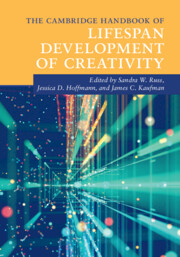Book contents
- The Cambridge Handbook of Lifespan Development of Creativity
- The Cambridge Handbook of Lifespan Development of Creativity
- Copyright page
- Dedication
- Contents
- Figures
- Tables
- Contributors
- Acknowledgments
- Introduction
- Part I Core Concepts of Lifespan Creativity Development
- Part II The Development of Creativity
- Part III Modes of Enhancement
- Part IV Environments and Contexts
- 18 Creative Identity Development in Classrooms
- 19 Creativity in Children’s Museums
- 20 Makers and Makerspaces
- 21 Organizations and Creativity
- 22 Creativity Development and Culture
- Part V Special Populations
- Index
- References
20 - Makers and Makerspaces
Developing Inventive Talent
from Part IV - Environments and Contexts
Published online by Cambridge University Press: 19 November 2021
- The Cambridge Handbook of Lifespan Development of Creativity
- The Cambridge Handbook of Lifespan Development of Creativity
- Copyright page
- Dedication
- Contents
- Figures
- Tables
- Contributors
- Acknowledgments
- Introduction
- Part I Core Concepts of Lifespan Creativity Development
- Part II The Development of Creativity
- Part III Modes of Enhancement
- Part IV Environments and Contexts
- 18 Creative Identity Development in Classrooms
- 19 Creativity in Children’s Museums
- 20 Makers and Makerspaces
- 21 Organizations and Creativity
- 22 Creativity Development and Culture
- Part V Special Populations
- Index
- References
Summary
Makerspaces and the Maker Movement provide a place and a pedagogy for the development of inventive talent. We describe the key components of Maker pedagogy, including tinkering, failing, sharing, and diversity of people and perspectives. The authors then provide a lifespan perspective on the development of inventive talent, from young Makers’ discovery of the tools and materials of making, to the adolescent learning and mentoring process, to the acquisition of expertise as an engineer, a designer, or developer.
- Type
- Chapter
- Information
- The Cambridge Handbook of Lifespan Development of Creativity , pp. 442 - 459Publisher: Cambridge University PressPrint publication year: 2021



